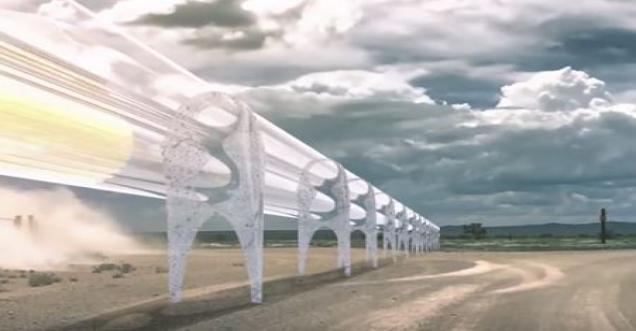
New Delhi, Hyperloop train in India: Hyperloop is a new mode of passenger and freight transportation that propels a pod-like vehicle through a near-vacuum tube at airline speeds. The pods accelerate to cruising speed gradually using a linear electric motor and glide above their track using passive magnetic levitation or air bearings. The tubes can go above ground on columns or underground, eliminating the dangers of grade crossings. It is hoped that the system will be highly energy-efficient, quiet and autonomous.
It's Elon Musk's idea, but Hyperloop Transportation Technologies is trying to make this "pipe dream" a reality.
The concept of high-speed travel in tubes has been around for decades, but there has been a resurgence in interest in pneumatic tube transportation systems since being reintroduced, using updated technologies, by Elon Musk after 2012, incorporating reduced-pressure tubes in which pressurized capsules ride on an air cushion driven by linear induction motors and air compressors.
Example if it is built
- Mumbai and the western India city of Pune— the travelling time will come to around 25 minutes from 3 hours
- Chennai to Bangalore will be just 25 min run
- A one way trip between Delhi and Mumbai on the Hyperloop is projected to take about 1 hour and 14 minutes to be precise, while a car takes roughly 23 hours (Image Credits: Dailymail)
NItin Gadkari wants Hyperloop in India. The Hyperloop Transportation Technologies (HTT), an American company that is already working on an ultra-fast rail system in America, is in talks with the Indian government to bring the technology to the country.
HTT submitted a letter of intent to transport Minister Nitin Gadkari about two weeks ago and is awaiting a response, Bibop Gresta, co-founder of HTT, told Indian media on Dec. 6. Once signed, the country could potentially possess the transport system in 38 months, “I think India is a perfect country to implement this project because the roads are not that good here. The transportation is not capable to sustain a growth in a country like India,” he said.
Once the Indian government signs the letter of intent, the company will need around eight months to conduct a feasibility study, according to Gresta. “Then after we get land permits, we can build a technically feasible Hyperloop in 38 months,” he said.
Prime minister Narendra Modi’s government has been toying with the idea of building bullet trains in India, at immense expense. For example, a proposed bullet train project between Ahmedabad in Gujarat to Mumbai is estimated to cost Rs1 lakh crore ($15 billion).
“You are going to spend $12 billion on a bullet train? Put $1 billion in Hyperloop and you will never need a bullet train,” Hyperloop is a much cheaper alternative, Gresta said.
How It will Work
Musk’s Hyperloop consists of two massive tubes stretching between Delhi and Mumbai. Pods carrying passengers would travel through the tubes at speeds topping out over 1223.1 km/hr. For propulsion, magnetic accelerators will be planted along the length of the tube, propelling the pods forward. The tubes would house a low pressure environment, surrounding the pod with a cushion of air that permits the pod to move safely at such high speeds, like a puck gliding over an air hockey table. Given the tight quarters in the tube, pressure buildup in front of the pod could be a problem. The tube needs a system to keep air from building up in this way. Musk’s design recommends an air compressor on the front of the pod that will move air from the front to the tail, keeping it aloft and preventing pressure building up due to air displacement. (source quora)












.jpg)














